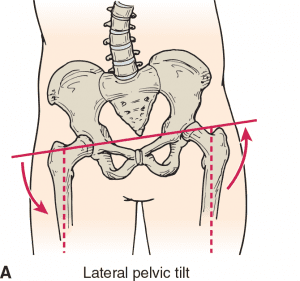Physical Address
304 North Cardinal St.
Dorchester Center, MA 02124
Physical Address
304 North Cardinal St.
Dorchester Center, MA 02124

Table of Contents
Lateral pelvic tilt exercises are exercises to help you correct your lateral pelvic tilt. These exercises are good ways of stretching the shorter muscles and strengthening the weaker ones. Here in this article, we have comprehensively outlined eight lateral pelvic tilt exercises that will help you.
The pelvis is the bone structure above the legs. It helps you walk, run and maintain good posture.

The pelvis should be positioned so that it is parallel to the shoulders and the floor. A lateral pelvic tilt occurs when one hip is higher than the other. It is a postural deviation in which one side of the pelvis is tilted to the left or right, causing one side of the hip to appear higher than the opposite side.
This can cause an increase in the shoulder on the same side or the opposite side of the upper hip, causing back and hip pain and also causing movement dysfunction. Lateral pelvic tilt can cause some muscles to become tight and also weaken some others.
Lateral pelvic tilt exercises can improve your posture by addressing the cause of the postural deviation rather than the symptoms of the deviation.
Massage can help relax tight muscles and performing lateral pelvic tilt exercises daily can help strengthen the weak muscles.
For more comprehensive information on lateral pelvic tilt, read our article on it by clicking this link.
Having a lateral pelvic tilt can cause problems such as:
To find out if your pool is uneven:
The line between your hands should be parallel to the ground, rather than ascending or descending. If the line is not parallel, you can have a lateral pelvic tilt.
If you are unsure whether you have a lateral pelvic tilt or not, or if you do not feel safe trying to diagnose yourself, you should ask a certified physiotherapist to examine you.
You can try these exercises at home to help correct a lateral pelvic tilt.
One of the lateral pelvic tilt exercises is the hip realignment. This exercise will help you align your hips with each other.
Another important lateral pelvic exercises is the reverse leg raises. This exercise will help strengthen the gluteal muscles and improve hip mobility. The lower hip will likely have weaker muscles, which can make this exercise difficult at first.
Do not arch your back when you lift your leg, as this can cause back pain. Tighten your abdominal muscles during this exercise to avoid overarching.
Hip adduction is one of the many lateral pelvic tilt exercises you can do at home. This exercise will help strengthen the adductor muscles, which are located on the inside of the thigh.
Make sure you don’t twist your hips when lifting your leg.
This exercise will strengthen your gluteal muscles and improve your balance.
Keep your spine straight while you perform this exercise using small, controlled movements. Do not swing your leg as this can cause back pain.
There are a lot of lateral pelvic tilt exercises and te clamshell is one of them. This exercise will help improve hip mobility and strengthen the gluteal muscles.
Make sure not to twist the spine during this exercise. This can lead to additional stress and back pain. Aim for short, controlled movements.
You can bring your legs closer to your body or stretch them further. Changing the position slightly will help you work all the muscles in that area.
This exercise aims to stretch and move the muscles and fasciae that connect the pelvis to the spine, shoulders, and limbs. It might be that one side of your body can move better than the other.
Like the previous exercise, this also produces the same benefits; However, the supine position reach puts less pressure on your lower back.
This exercise stretches the muscles and fascia along the pelvis, torso, and shoulders while keeping the lower body stable in the kneeling position.
I advise that before trying out any lateral pelvic tilt exercises you need to consult a qualified health and exercise professional to determine the best strategy for treating your lateral pelvic tilt condition. Since everyone has a different body, health and causes of pain that cause a lateral pelvic tilt, an exercise or method that works for one person can harm another, says physiotherapist Gray Cook, author of “Movement”. Corrective training for any condition should be based on each individual, never with a single method.
Lateral pelvic tilt causes pain and discomfort. It makes your walking uneven. However, doing the correct lateral pelvic tilt exercises can help correct this.
Use the mirror test to track your progress. Continue to do these exercises even after realigning your pelvis. This will prevent the condition from developing again.
Source: Healthline, Livestrong.com